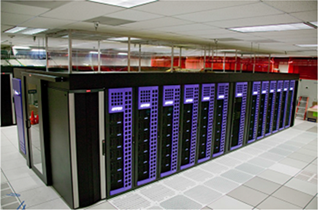Despite the vast computational power available in today’s extreme-scale computing systems, there are still certain types of problems for which that power is inadequate and silicon-based computing devices will likely never be able to solve. Sandia is exploring technologies necessary to enable a new paradigm of computing that goes beyond the limits of Moore’s Law. Core areas of competency are post-CMOS processors, quantum information processing, simulation of solid state and quantum devices, and development of computing methods to support materials and device simulations.
Scalable Computing

The CCR has a legacy of leadership in high-performance computing (HPC) at extreme scales. First-of-a-kind platforms, such as the Intel Paragon, ASCI Red (the world’s first teraflops computer), and Red Storm (co-developed by Cray), helped form the basis for one of the most successful supercomputer product lines ever—the Cray XT series. The CCR continues to play an important role, working closely with HPC vendors to provide solutions for next-generation systems that meet the complex mission needs of the laboratories. Our particular interests include advanced architecture design and evaluation, including Beyond Moore capabilities, scalable system software, scalable input/output, and algorithms.
Focus Areas
Our efforts in scalable computer architecture seek to explore advancements in the design and integration of processors, memory, and networks necessary to effectively deploy and use the largest parallel computing systems in the world. Core areas of competency are hardware simulation, microarchitectures, network interface design, system reliability, and energy/power analysis.
Effective use of extreme-scale computing systems depends on the availability of scalable parallel algorithms. Sandia has a long history of activities in this area, with a focus on algorithms to enable parallel science and engineering simulations. Core areas of competency include dynamic load balancing for adaptive applications, iterative linear solvers, eigensolvers, and preconditioning methods.